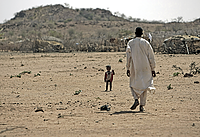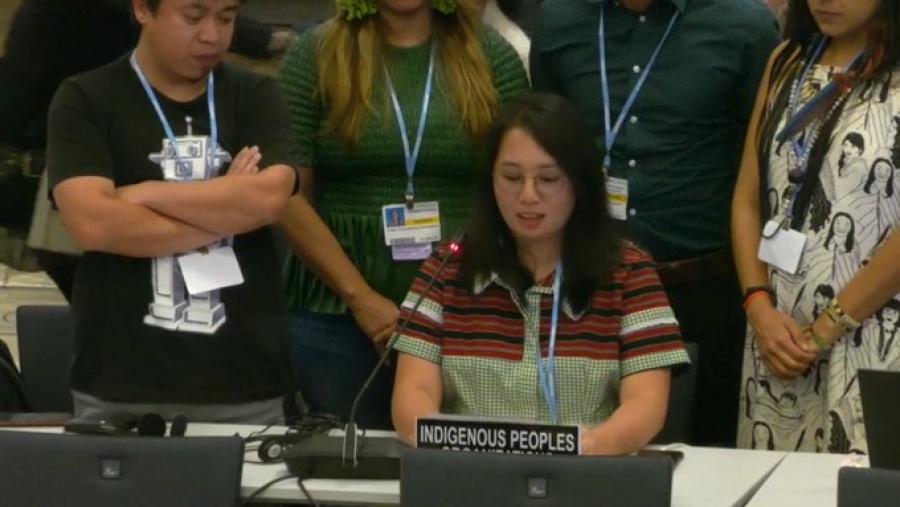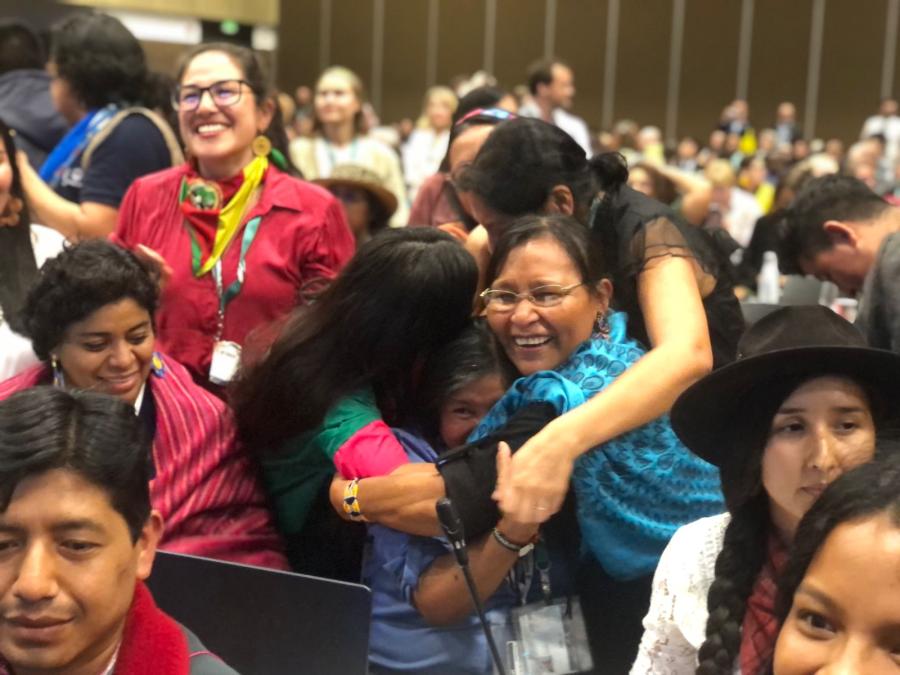Just five years ago, governments, pundits, and the general public were talking about climate change—to the extent they were talking about it at all—as a vague issue that was open to question. Today it is not just accepted as a fact; it is seen as a crisis. But indigenous peoples have known for decades that climate change is happening, and they know better than most exactly what it means.
 Sudan: Nomad and his son: A nomad and his son in Darfur, Sudan, live in what is already a marginal climate. Even small shifts in rainfall and temperature can make this land unihabitable. UN Photo/Stuart Price
Sudan: Nomad and his son: A nomad and his son in Darfur, Sudan, live in what is already a marginal climate. Even small shifts in rainfall and temperature can make this land unihabitable. UN Photo/Stuart Price
Indigenous peoples tend to live close to the land. They are subsistence farmers, herders, fishers, and hunters, with millennia of collective knowledge about the ecology of their surroundings. With that knowledge and experience, even tiny changes in water cycles, wildlife, soil, and weather are readily apparent. An indigenous farmer notices that a certain insect is slightly less abundant this year or that a particular flower is blooming three days earlier.
Unfortunately, the same closeness to the land that has given indigenous peoples early warning about global warming also means that they suffer the consequences of it to a far greater degree than others. The trends of history and hegemony have left many indigenous peoples living on land that is already marginal, so even relatively small changes in temperature or rainfall have an outsized consequence. The Maasai, who originally grazed their cattle on lush grasslands, have been pushed by colonization and the power of dominant societies onto semiarid scrubland where their herds can find just enough food under the best of climatic conditions. A drought or heat wave can spell disaster for them. If melting glaciers and reduced winter snowpack in mountains cut the amount of water available in the lowlands, an indigenous subsistence farmer in the valley below often does not have the technical or financial option of drilling into aquifers or using irrigation, and if his crops fail, the consequence can mean starvation for his family.
Of course, indigenous people have dealt with climate change and environmental upheaval for thousands of years; adaptability and resourcefulness are the hallmarks of any indigenous culture. Megan Gray’s article about Native American wind energy initiatives on page 35 is a prime example of this principle. And indigenous peoples collectively have developed considerable skills and presence in international bodies like the United Nations, where they are pressing their case about climate change. The recent UN Permanent Forum on Indigenous Issues was focused entirely on this issue, and the land rights promoted in the Declaration on the Rights of Indigenous Peoples clearly have application to this subject. But for all that, indigenous peoples were physically shut out of the world climate summit in Bali in December. And on a local level, the possibility of relocating, which was the most common adaptation to climate change in the past, is no longer an option in today’s vastly overcrowded world.
One of the cruelest ironies is that some of the biggest current threats to indigenous lands are efforts to alleviate global warming. As the industrialized world grudgingly comes to realize that petroleum-based energy is untenable, it is turning to alternative energy-generation strategies. Hydroelectric power seems, at least to dominant cultures, like an ideal alternative to oil. It is perceived as clean, perpetual power that can be generated domestically. And the number of dams being built has been increasing. According to Sandra Postel of the Global Water Policy Project, there are now 45,000 large dams in the world, with an average of two more being added every day. But many of those dams are being built across rivers in indigenous territories, flooding villages, destroying farmlands and hunting grounds, and disrupting fishing. Those indigenous communities rarely have the political power to fight against the dams, especially when the majority society perceives that hydro power will help slow global warming, which will benefit the whole planet (an argument that would carry more moral weight if governments were willing to compensate the indigenous communities who otherwise carry the cost of saving the world).
Concerns over greenhouse gases have even reached a point where people are seeing nuclear power as an attractive option—in the process ignoring its deadly side effects. Indigenous peoples are not so blithe about nuclear power. In anticipation of a nuclear renaissance, the price of uranium has skyrocketed over the past year or two, prompting mining companies to reopen old uranium mines and establish new ones. But 70 percent of all uranium on earth is on indigenous lands, and indigenous people, either as miners or innocent bystanders, are exposed to dangerous amounts of radiation. In the Navajo Nation alone, an estimated 400 native mine workers died from radiation exposure during the first mining boom in the 1950s and ’60s. As much as 22 million tons of toxic mine tailings have been left in the western United States, again mostly on indigenous lands. The proposed Yucca Mountain nuclear repository, which would hold 300 million pounds of high-level nuclear waste, is on treaty lands of the Western Shoshone.
As Vicky Tauli-Corpuz reports in this issue, biofuel, which is increasingly touted as a panacea, again benefits the most industrial societies at the expense of indigenous ones. The problem here is two-fold. The world’s current food crisis—a drastic shortage of rice and other staple grains—is at least partly due to having an ever-larger percentage of crops going to fuel vehicles instead of feeding people. As supplies go down and prices go up, the poorest people in any society suffer most, and typically indigenous peoples are the poorest of the poor. The second problem with biofuels lies in the land being devoted to growing those crops. Tauli-Corpuz explains how oil palm plantations are being carved out of indigenous territories with astonishing and increasing frequency. The same thing is happening in many other countries with soy and other biofuel crops.
One of the global climate change mitigation programs that appears most promising is, in fact, likely to further impoverish indigenous communities: a new program from the World Bank that will pay governments for not cutting down their forests, which act as a carbon reservoir. Since the majority of existing forest tracts (and 80 percent of the world’s biodiversity) are on indigenous territories, and since indigenous peoples have long managed their forests as a sustainable natural resource, they should be the principal beneficiaries of such a plan. But the bank set up the program without substantial consultation with indigenous peoples, and they structured it to be a government-to-government system, so the money will go to indigenous communities only if their government decides to pay them for their ecological services—an unlikely scenario. Instead, the money will likely be paid to logging companies to keep them from logging. Moreover, the system counts tree plantations as forest, reinforcing the oil palm plantations that are already displacing indigenous peoples and natural forests.
Indigenous peoples not only are suffering the consequences of climate change more acutely; they are facing them sooner. Consider the question raised in Casey Beck and Austin Blair’s article about Kiribati on page 21. That island nation is facing the prospect of complete inundation as sea levels rise; it seems inevitable that within a few years the entire country will be underwater, so the president has to contemplate moving his entire population to another country. “Can we remain nationals of Kiribati when we are living in Australia?” he asks. “What would be our citizenship? Do we still have sovereignty of Kiribati when there is no longer the country of Kiribati?” These are questions that will increasingly be asked by indigenous peoples as they are displaced by drought, deforestation, and land loss. Some of them will be displaced across national borders, but they will not be refugees. That term suggests a temporary status; these people will be moving permanently, and they will be moving as an entire people, not just as individuals. No one has yet considered, let alone planned for, the issues of sovereignty, identity, and culture that will flow from this situation.
The problems faced by indigenous peoples are harbingers of what all peoples will face eventually, and they dramatically expose the ideological shibboleths the rest of us are not yet willing to examine: market-based solutions for every problem, the tendency to see carbon trading as a means to continue business as usual, the desire to keep our cars at any price, and many others. But indigenous peoples offer more than a rude mirror. They also offer an alternative point of view about the world, one that sees natural processes as cyclical, one that reflects respect for the earth, and, most of all, one that considers all our actions in the context of future generations.
Mark Cherrington is the editor of Cultural Survival Quarterly.



